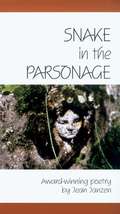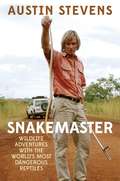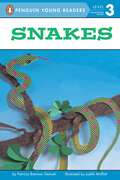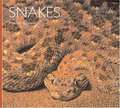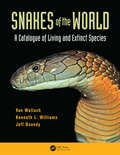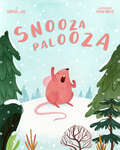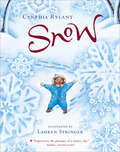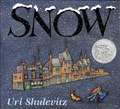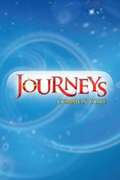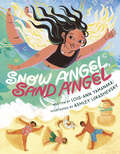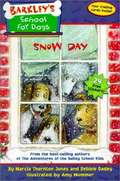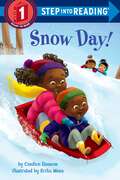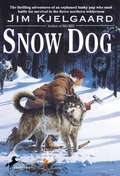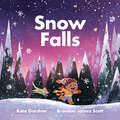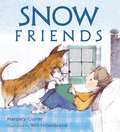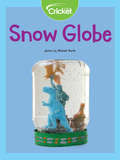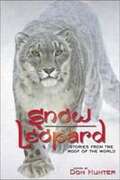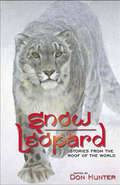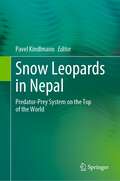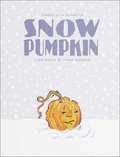- Table View
- List View
Snake in the Parsonage: Award-winning Poetry
by Jean JanzenSnake in the Parsonage includes the poems for which Jean Janzen received The Creative Writing Fellowship in Poetry from the National Endowment for the Arts. Selected by a panel of major poets. Once again Jean Janzen shows us life -- colored deeply and in irrepressible light. She finds both ecstasy and incompleteness -- while waiting, at the piano and in the halls of the old people's home, lying in the field, shrieking in the cellar, standing at the blackboard.
Snakemaster: Wildlife Adventures with the World's Most Dangerous Reptiles
by Austin StevensKnown as the original "Snakemaster" from his various television shows, Austin Stevens is one of the most famous herpetologists in the world. From his show Austin Stevens: Snakemaster on Animal Planet to his many appearances in the media, Stevens is known as an incredibly smart, yet incredibly insane animal lover.In Snakemaster, Austin Stevens tells incredible stories of his many run-ins with dangerous animals and reptiles. From wrestling with a reticulated python to panicking after being bitten by the infamous Gaboon viper, Stevens brings you into his world of wildlife and tells the story of how a boy from Pretoria, South Africa, became one of the most widely known herpetologists in the world.With incredible photographs taken by Stevens himself, you'll be able to place yourself in his world-from the deserts of Africa to the jungles of Borneo. Sharing incredible stories of his love of animals and nature, this one-of-a-kind collection of stories will make you laugh, cry, and shiver with fear!
Snakemaster: Wildlife Adventures with the World?s Most Dangerous Reptiles
by Austin StevensKnown as the original "Snakemaster” from his various television shows, Austin Stevens is one of the most famous herpetologists in the world. From his show Austin Stevens: Snakemaster on Animal Planet to his many appearances in the media, Stevens is known as an incredibly smart, yet incredibly insane animal lover.In Snakemaster, Austin Stevens tells incredible stories of his many run-ins with dangerous animals and reptiles. From wrestling with a reticulated python to panicking after being bitten by the infamous Gaboon viper, Stevens brings you into his world of wildlife and tells the story of how a boy from Pretoria, South Africa, became one of the most widely known herpetologists in the world.With incredible photographs taken by Stevens himself, you’ll be able to place yourself in his world-from the deserts of Africa to the jungles of Borneo. Sharing incredible stories of his love of animals and nature, this one-of-a-kind collection of stories will make you laugh, cry, and shiver with fear!
Snakes (Nature's Children)
by Tim HarrisWhere do snakes live? What do snakes eat? How big are snakes? Are all snakes dangerous? Find out the answers to these questions and learn all about the physical characteristics, behavior, and habitats of snakes.
Snakes (Penguin Young Readers, Level 3)
by Patricia Brennan DemuthAre there some snakes as long as school busses? Can some snakes swallow a whole pig in one bite? Find out more about snakes in this exciting book!
Snakes (World Life Library)
by Martin Gaywood Ian SpellerbergSnakes are a remarkably successful group of animals, found in a wide range of habitats and on almost every continent. There are some 2,700 species of snakes and these different species have a wide range of physical features and have evolved a variety of life styles. Drawing on the latest research, Martin Gaywood and Ian Spellerberg examine snakes' origins and development, their incredible diversity in adapting to widely differing environments, their role as predators and prey, and their complicated relationship with humans. He stresses the need for the conservation of snakes, which face threats from habitat destruction, persecution, and collection.
Snakes of the World: A Catalogue of Living and Extinct Species
by Van Wallach Kenneth L. Williams Jeff BoundySnakes of the World: A Catalogue of Living and Extinct Species-the first catalogue of its kind-covers all living and fossil snakes described between 1758 and 2012, comprising 3,509 living and 274 extinct species allocated to 539 living and 112 extinct genera. Also included are 54 genera and 302 species that are dubious or invalid, resulting in reco
Snoozapalooza
by Kimberlee GardWinter is here and it's time to cozy up for a hibernation, but as more and more animals pile into the den, the sound of snoring just might be enough to wake up the whole forest!
Snow
by Cynthia RylantCynthia Rylant&’s lyrical descriptions of the sights and feelings evoked by falling snow blend gorgeously with the rich and beautiful world created by Lauren Stringer&’s illustrations, in which a young girl, her friend, and her grandmother enjoy the many things a snowy day has to offer.
Snow
by P. D. Eastman Roy MckieFrom the book: Snow! Snow! Come out in the snow. Snow! Snow! Just look at the snow! Come out! Come out! Come out in the snow. ... Picture descriptions add to the enjoyment of this book.
Snow
by Uri ShulevitzThis Caldecott Honor Book and "Publishers Weekly" Best Book of the Year is now in paperback. As snowflakes slowly come down, one by one, people in the city ignore them and only a boy and his dog think that the snowfall will amount to anything. Full color.
Snow Angel, Sand Angel
by Lois-Ann YamanakaA celebration of home, family, and finding beauty in your heritage, beautifully illustrated by the artist behind Anti-Racist Baby. Claire has been surrounded by the deep blue waves of Hapuna Beach and the magnificent mountains of Hawai'i all her life, but has never, ever seen snow. When her father drives her and her family to the top of the Mauna Kea, she can't help but to be disappointed...it's not the winter wonderland she's always dreamed of. And that's what she wants, more than anything. But as Claire edges ever closer to the new year, she wonders if maybe-- just maybe--she can delight in the special joys of winter in her own way--right there, on her Big Island of Hawaii.Includes backmatter that captures the environmental culture of Hawaii, and will teach children not only about the local flora and fauna, but also the value of being environmentally friendly.
Snow Day (Barkley's School for Dogs #5)
by Debbie Dadey Marcia Thornton JonesA snowstorm gives Barkley's School an unexpected snow day, and the dogs have never had so much fun playing. But when one of the dogs is caught in the blizzard, Jack and his friends will have to work together to save the day.
Snow Day! (Step into Reading)
by Candice RansomA Step 1 reader to welcome winter, featuring the family from Pumpkin Day! and Apple Picking Day!The brother and sister from PUMPKIN DAY! and APPLE PICKING DAY! have woken up to a winter wonderland--it's a snow day! Read along as they engage in favorite winter activities with their neighborhood friends on their day off from school. Easy-to-follow rhyme ensures a successful reading experience, and bright, fun art enhances the story.Step 1 Readers feature big type and easy words. Rhymes and rhythmic text paired with picture clues help children decode the story. For children who know the alphabet and are eager to begin reading.
Snow Dog, Sand Dog
by Linda Joy Singleton Jess GoldenWhat would you do if you were allergic but really wanted a dog? In this whimsical picture book, a young girl uses her crafty nature and imagination to create four-legged friends each season as the weather changes. She builds a dog out of snow in winter, sand in summer, leaves in fall, and flowers in spring. This is a fixed-format ebook, which preserves the design and layout of the original print book.
Snow Dog: A Yearling Book (Famous Dog Stories)
by Jim KjelgaardSurvival of the Fittest The steel-gray husky Chiri was just a puppy when he watched the black wolf kill his mother and two brothers. Left alone in the snow-covered land of the coyote, caribou, and grizzly, Chiri learned to fend for himself, to hunt, and to survive by his own keen instinct and natural intelligence. Now grown and full of courage and cunning, Chiri forms a tentative bond with trapper Link Stevens, the only human he's ever learned to trust. But the husky knows that one day soon he will have to face the black wolf again--and this time only one of them will survive.
Snow Falls
by Kate GardnerAn introduction to the magic, beauty and fun of snow for very young readers, perfect for fans of Ezra Jack Keats' classic The Snowy Day.Snow softens, snow tricks, snow tracks, snow glows and snow snows and snows and snows, transforming a small village into a winter wonderland. A girl and her dog set out and make the most of every snow-filled moment: sledding, building snowmen and snowforts, making snowangels (and snowdogs), and drinking cocoa by a cozy fire as the snow continues to fall. This luminous and lively picture book celebrates the beauty, magic and excitement of snow with simple, easy-to-read text, comprised almost solely of verbs and action words, and gorgeous art that highlights the amazing colors of a snowy day. As inviting as the first snowfall, but so much warmer, Snow Falls encourages little people and big people to go outside and enjoy the snow . . . before it goes!
Snow Friends
by Margery CuylerA charming winter picture book about friendship and dogs set against the perfect snowy day.Snow! Snow! And more snow! It’s the perfect day to play in the newly fallen snow. Oscar can’t contain his excitement—and before his boy Matt knows it, Oscar is off on a wintry adventure. Dashing through the woods, Oscar finds another dog playing in the snow—Daisy! Together they find all sorts of adventures—ice skating making dog angels in the snow, and they even build an igloo! Snow Friends is a seasonal friendship story with all the timeless understated charm of The Biggest, Best Snowman, by the same bestselling team of Margery Cuyler and Will Hillenbrand.Christy Ottaviano Books
Snow Globe
by Liz HuyckA gentle shake creates a magical snowfall on a miniature snow globe scene. Create your own wonderland in this fun winter activity.
Snow In Jerusalem
by Deborah Da CostaAvi and Hamudi are two boys who live in Jerusalem's Old City -- Avi in the Jewish Quarter and Hamudi in the Muslim Quarter. To each boy, the other's neighborhood is an alien land. <P><P>And although neither boy knows it, both are caring for the same beautiful white stray cat. One day the boys follow the cat as she travels the winding streets and crosses the boundaries between the city's quarters. And on this journey something wonderful happens, as unexpected as a snowfall in Jerusalem.
Snow Leopard
by Don HunterLike no other large cat, the snow leopard evokes a sense of myth and mysticism, strength and spirit shrouded in a snowy veil, seldom seen but always present. Giving a voice to the snow leopard, this collection of powerful first person accounts from an impressive cadre of scientist-adventurers grants readers a rare glimpse of this elusive cat and the remarkable lives of those personally connected to its future. These Stories from the Roof of the World resonate with adventure, danger, discovery, and most importantly hope for this magnificent big cat.Very little has been written about this mystical creature. Its remote and rugged habitat among the mightiest collection of mountains on Earth, proclaimed "The Roof of the World" by awe-struck explorers, make it one of the most difficult and expensive animals to study. After a millennia thriving in peaceful isolation, human encroachment, poaching and climate change threaten the snow leopards survival. Speaking on behalf of the snow leopard, these heart-felt stories will inform and inspire readers, creating the vital connection needed to move people toward action in saving this magnificent cat. Contributors include: Ali Abutalip Dahashof, Som B. Ale, Avaantseren Bayarjargal, Yash Veer Bhatnagar, Joseph L. Fox, Helen Freeman, Darla Hillard, Don Hunter, Shafqat Hussain, Rodney Jackson, Jan E. Janecka, Mitchell Kelly, Ashiq Ahmad Khan, Nasier A. Kitchloo, Evgeniy P. Kashkarov, Peter Matthiessen, Kyle McCarthy, Tom McCarthy, George B. Schaller, and Rinchen Wangchuk.
Snow Leopard: Stories from the Roof of the World
by Don Hunter"Just recently, we once again traveled the high roads of snow leopard country, enjoying the beauty of Ladakh's iconic monasteries and watching blue sheep graze steep mountainsides. We saw no snow leopards but sensed their presence, feeling lucky and thrilled to be under the distant gaze of this magnificent cat. May you experience a similar feeling as you read about the snow leopard in this remarkable collection." -Robert Bateman, from the foreword. Like no other large cat, the snow leopard evokes a sense of myth and mysticism, strength and spirit shrouded in a snowy veil, seldom seen but always present. Giving a voice to the snow leopard, this collection of powerful first person accounts from an impressive cadre of scientist-adventurers grants readers a rare glimpse of this elusive cat and the remarkable lives of those personally connected to its future. These Stories from the Roof of the World resonate with adventure, danger, discovery, and most importantly hope for this magnificent big cat. Very little has been written about this mystical creature. Its remote and rugged habitat among the mightiest collection of mountains on Earth, proclaimed "The Roof of the World" by awe-struck explorers, make it one of the most difficult and expensive animals to study. After a millennia thriving in peaceful isolation, human encroachment, poaching and climate change threaten the snow leopards survival. Speaking on behalf of the snow leopard, these heart-felt stories will inform and inspire readers, creating the vital connection needed to move people toward action in saving this magnificent cat. Contributors include: Ali Abutalip Dahashof, Som B. Ale, Avaantseren Bayarjargal, Yash Veer Bhatnagar, Joseph L. Fox, Helen Freeman, Darla Hillard, Don Hunter, Shafqat Hussain, Rodney Jackson, Jan E. Janecka, Mitchell Kelly, Ashiq Ahmad Khan, Nasier A. Kitchloo, Evgeniy P. Kashkarov, Peter Matthiessen, Kyle McCarthy, Tom McCarthy, George B. Schaller, and Rinchen Wangchuk
Snow Leopards in Nepal: Predator-Prey System on the Top of the World
by Pavel KindlmannSnow leopard (Panthera uncia) is an endangered species, and its population size is steadily declining. The main threats to the snow leopard include illegal trade, conflict with locals (human-snow leopard conflict), lack of conservation, awareness and policy, and climate change. To avoid its extinction, we badly need a good knowledge of its ecology, distribution and population dynamics, including interactions with its prey, which will take into account various scenarios of changes in climate and human impact on snow leopard. This book aims to put together a considerable amount of unpublished data collected by the co-author of most of the chapters, Bikram Shrestha, which might be useful for other researchers working on snow leopard. In addition, researchers might find it useful to have a key for determining the diet of snow leopard based on remnants of its food in its scats. Last, but not least, based on the difficulty we experienced trying to compare and combine different sets of results, we propose a general methodology for collecting data. Thus, this book is not an all-encompassing compendium, but an attempt to fill some gaps in the literature and to show, how to publish new data on snow leopard in a useful and workable way. The first part, describing the main features of snow leopard and its main prey ecology, is followed by a comprehensive review of data available on its abundance and threats to its survival. The third, most extensive part—the substance of the book—presents new data from 15 years of intensive camera trapping combined with scat sampling. These data are analyzed by means of advances GIS and genetic techniques, which yields a large amount of conservation implications.The purpose of this book is to provide a tool for both environmental managers and researchers to find quickly what is known about this species for conservation planning and for an effective protection of snow leopard. However, enthusiasts interested in wild cats may welcome the book, too.
Snow Pumpkin
by Carole Lexa SchaeferThe author-illustrator team of the celebrated picture book The Squiggle team up again to tell of a heartwarming and surprising snowy adventure. No school tomorrow! With a few inches on the ground, Lily is off to the park bright and early to find her friend Jesse and build the season's first snowman. But everyone's already at the park and everyone's building snowmen. Lily and Jesse roll enough snow for the body, but there's not enough for a head until Lily gets an idea. A head should be round, but it doesn't have to be white. It could even be ... a pumpkin! This story gives the feeling of community in a big city.
